brakes MERCEDES-BENZ CL-Class 2014 C217 Owner's Manual
[x] Cancel search | Manufacturer: MERCEDES-BENZ, Model Year: 2014, Model line: CL-Class, Model: MERCEDES-BENZ CL-Class 2014 C217Pages: 494, PDF Size: 13.55 MB
Page 8 of 494
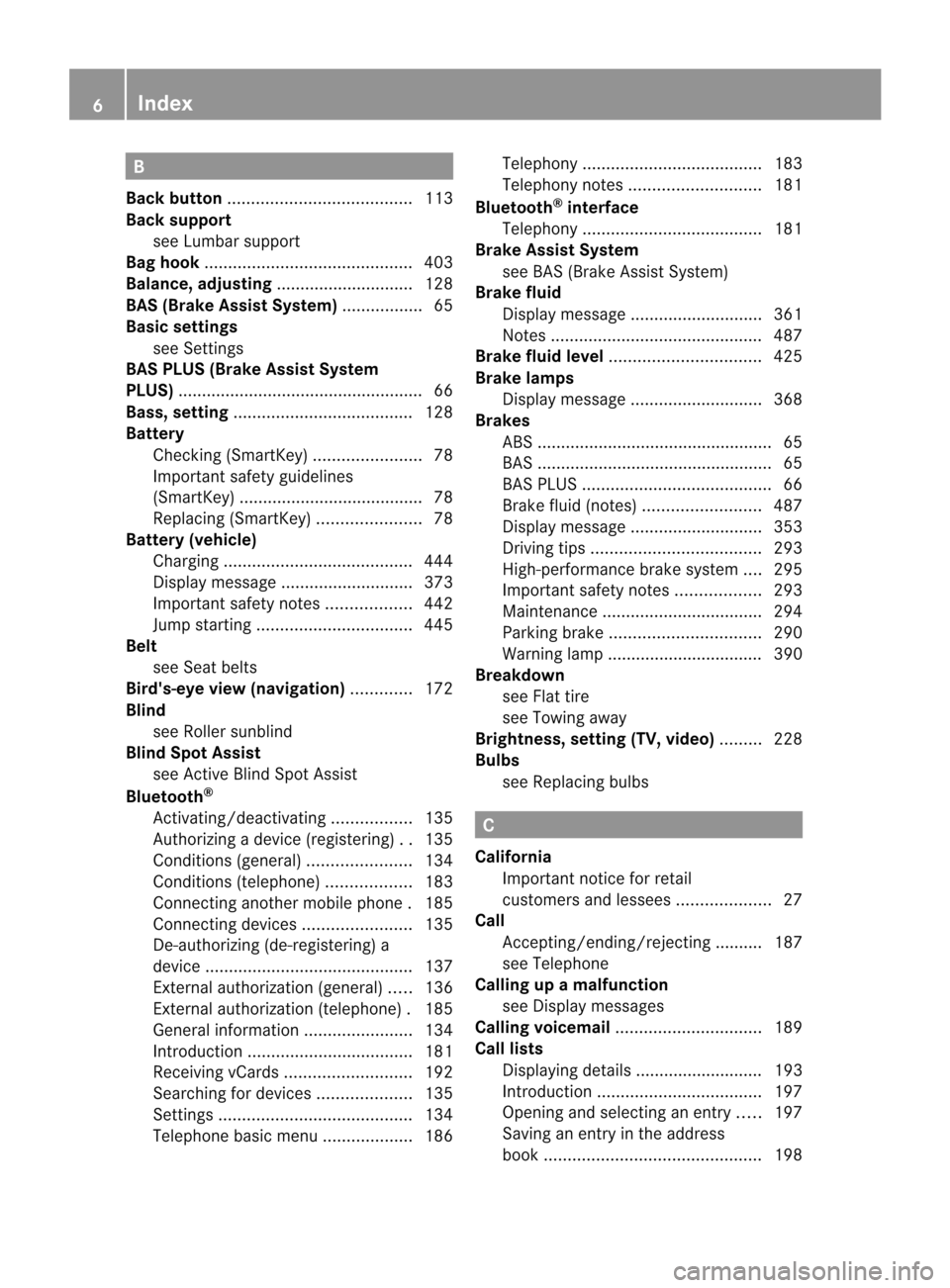
B
Back button ....................................... 113
Back support see Lumbar support
Bag hook ............................................ 403
Balance, adjusting .............................128
BAS (Brake Assist System) .................65
Basic settings see Settings
BAS PLUS (Brake Assist System
PLUS) .................................................... 66
Bass, setting ...................................... 128
Battery Checking (SmartKey) .......................78
Important safety guidelines
(SmartKey) ....................................... 78
Replacing (SmartKey) ......................78
Battery (vehicle)
Charging ........................................ 444
Display message ............................ 373
Important safety notes ..................442
Jump starting ................................. 445
Belt
see Seat belts
Bird's-eye view (navigation) .............172
Blind see Roller sunblind
Blin dSpot Assist
see Active Blind Spot Assist
Bluetooth ®
Activating/deactivating .................135
Authorizing a device (registering) ..135
Conditions (general )...................... 134
Conditions (telephone ).................. 183
Connecting another mobile phone .185
Connecting devices .......................135
De-authorizing (de-registering) a
device ............................................ 137
External authorization (general) .....136
External authorization (telephone) .185
General information .......................134
Introduction ................................... 181
Receiving vCards ........................... 192
Searching for devices ....................135
Settings ......................................... 134
Telephone basic menu ...................186Telephony
...................................... 183
Telephony notes ............................ 181
Bluetooth ®
interface
Telephony ...................................... 181
Brake Assist System
see BAS (Brake Assist System)
Brake fluid
Display message ............................ 361
Notes ............................................. 487
Brake fluid level ................................ 425
Brake lamps Display message ............................ 368
Brakes
ABS .................................................. 65
BAS .................................................. 65
BAS PLUS ........................................ 66
Brake fluid (notes) .........................487
Display message ............................ 353
Driving tips .................................... 293
High-performance brake system ....295
Important safety notes ..................293
Maintenance .................................. 294
Parking brake ................................ 290
Warning lamp ................................. 390
Breakdown
see Flat tire
see Towing away
Brightness, setting (TV, video) .........228
Bulbs see Replacing bulbs C
California Important notice for retail
customers and lessees ....................27
Call
Accepting/ending/rejecting .......... 187
see Telephone
Calling up a malfunction
see Display messages
Calling voicemail ............................... 189
Call lists Displaying details ........................... 193
Introduction ................................... 197
Opening and selecting an entry .....197
Saving an entry in the address
book .............................................. 1986
Index
Page 12 of 494
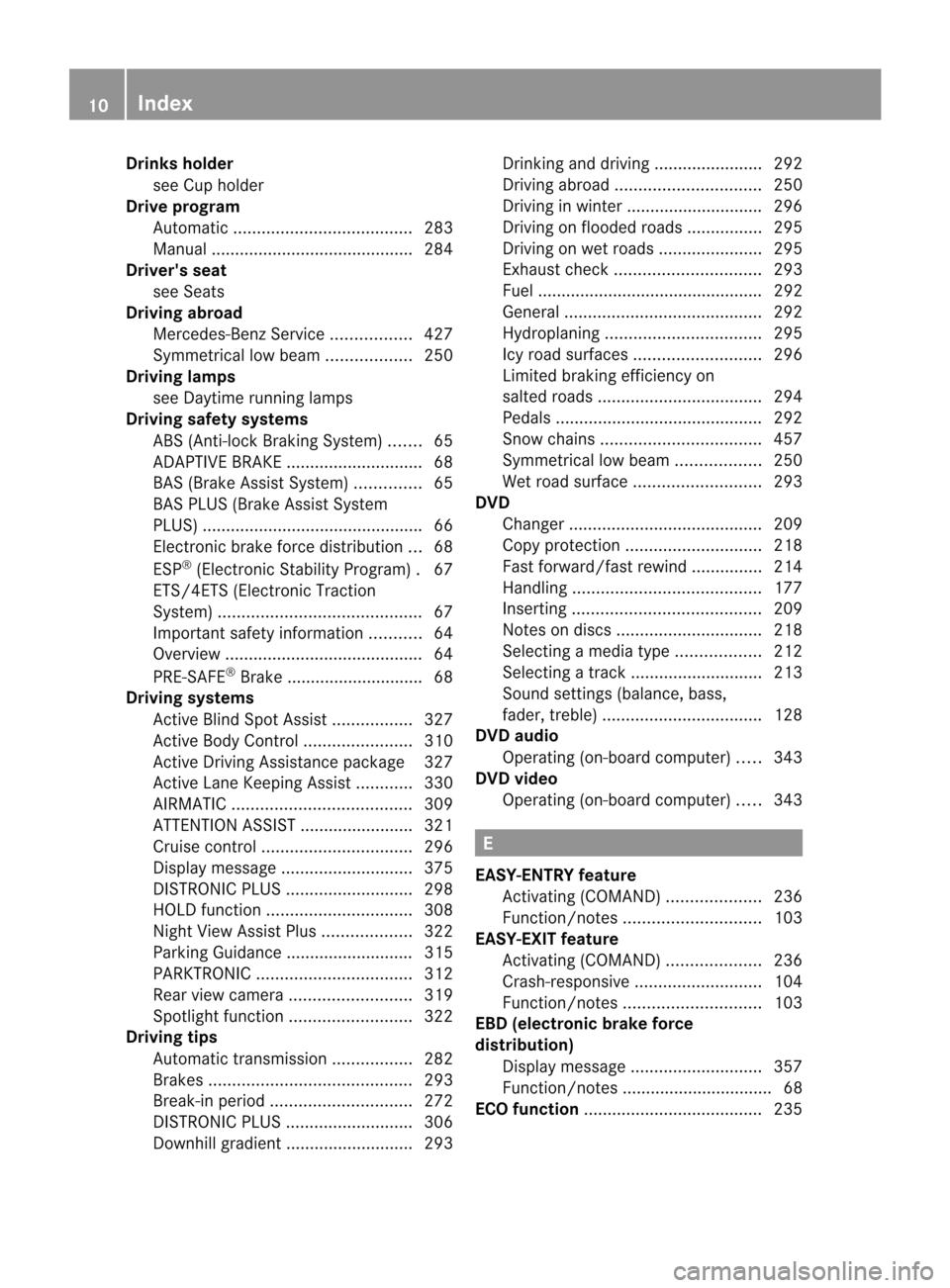
Drinks holder
see Cup holder
Drive program
Automati c...................................... 283
Manual .......................................... .284
Driver's seat
see Seats
Driving abroad
Mercedes-Benz Service .................427
Symmetrical low bea m.................. 250
Driving lamps
see Daytime running lamps
Driving safety systems
ABS (Anti-lock Braking System) .......65
ADAPTIVE BRAKE ............................. 68
BAS (Brake Assist System) ..............65
BAS PLUS (Brake Assist System
PLUS) .............................................. .66
Electroni cbrake force distribution ...68
ESP ®
(Electronic Stability Program) .67
ETS/4ETS (Electronic Traction
System) ........................................... 67
Important safety information ...........64
Overview .......................................... 64
PRE-SAFE ®
Brake ............................ .68
Driving systems
Active Blind Spot Assis t................. 327
Active Body Control .......................310
Active Driving Assistance package 327
Active Lane Keeping Assist ............330
AIRMATIC ...................................... 309
ATTENTION ASSIST ........................321
Cruise control ................................ 296
Display message ............................ 375
DISTRONI CPLUS ........................... 298
HOLD function ............................... 308
Nigh tView Assist Plus ...................322
Parking Guidance ........................... 315
PARKTRONI C................................. 312
Rea rview camera .......................... 319
Spotlight function .......................... 322
Driving tips
Automatic transmission .................282
Brakes ........................................... 293
Break-in period .............................. 272
DISTRONI CPLUS ........................... 306
Downhill gradient ........................... 293Drinking and driving
.......................292
Driving abroad ............................... 250
Driving in winter ............................ .296
Driving on flooded road s................ 295
Driving on wet road s...................... 295
Exhaus tcheck ............................... 293
Fuel ................................................ 292
General .......................................... 292
Hydroplaning ................................. 295
Icy road surfaces ........................... 296
Limited braking efficiency on
salted road s................................... 294
Pedals. ........................................... 292
Snow chains .................................. 457
Symmetrical low bea m.................. 250
Wet road surface ........................... 293
DVD
Changer ......................................... 209
Cop yprotection ............................. 218
Fast forward/fast rewind ...............214
Handling ........................................ 177
Inserting ........................................ 209
Notes on discs ............................... 218
Selecting amedia type .................. 212
Selecting atrack ............................ 213
Sound settings (balance, bass,
fader, treble ).................................. 128
DVD audio
Operating (on-board computer) .....343
DVD video
Operating (on-board computer) .....343 E
EASY-ENTRY feature Activating (COMAND) ....................236
Function/notes ............................. 103
EASY-EXIT feature
Activating (COMAND) ....................236
Crash-responsive ........................... 104
Function/notes ............................. 103
EBD (electronic brake force
distribution)
Display message ............................ 357
Function/notes ................................ 68
ECO function ...................................... 23510
Index
Page 27 of 494

W
Waiting call ........................................ 189
Warning and indicator lamps ABS ................................................ 391
Brakes ........................................... 390
Check Engine ................................. 396
Distance warning ........................... 397
DISTRONI CPLUS ........................... 397
ESP ®
.............................................. 393
ESP ®
OFF ....................................... 393
Fuel tank ........................................ 396
Overview .......................................... 36
PASSENGER AIR BAG OFF
indicator lamp .................................. 50
Reserve fuel ................................... 396
Seat bel t........................................ 389
SRS ................................................ 395
Tire pressure monitor ....................398
Warranty ............................................ 482
Washer fluid Display message ............................ 387
Weather Band
Searching for achannel ................. 202
Switching on .................................. 202
Wheel bol ttightening torque ...........441
Wheel chock ...................................... 438
Wheels Changing awheel .......................... 437
Checking ........................................ 455
Cleaning ......................................... 429
Cleaning (warning) .........................477
Important safety notes ..................454
Interchanging/changing ................477
Mounting anew wheel ................... 440
Removing awheel .......................... 440
Storing ........................................... 477
Tightening torque ........................... 441
Whee lsize/tir esize ....................... 477
Window curtain air bag
Display message ............................ 363
Operation ........................................ .50
Windows
see Side windows
Windshield
Defrosting ...................................... 265
Infrared reflective .......................... 417Windshiel
dwasher fluid
see Windshield washer system
Windshiel dwasher system ..............425
Notes ............................................. 488
Windshiel dwipers
Problem (malfunction) ...................259
Replacing the wiper blades ............258
Switching on/off ........................... 257
Winte rdriving
Important safety note s.................. 456
Slippery road surfaces ...................296
Snow chains .................................. 457
Winter tires
M+S tires ....................................... 456
Wiper blades
Cleaning ......................................... 430
Important safety notes ..................258
Wooden trim (cleaning instructions) 433
Workshop see Qualified specialist workshop Index
25
Page 38 of 494

Warning and indicator lamps
Function Page
:
Turn signal 252
;
Electric parking brake (red) 390
F
(USA only) !
(Canada only) =
Electric parking brake
(yellow)
390
F
(USA only) !
(Canada only) ?
Seat belt 389
A
ESP
® 393
B
Distance warning
397 Function Page
C
Brakes 390
$
(USA only) J
(Canada only) D
ESP
®
OFF 393
E
Tire pressure monitor 398
F
Check engine 396
G
ABS 391
H
SRS 395
I
High-beam headlamps 253
J
Reserve fuel 39636
Instrument clusterAt a glance
Page 68 of 494

The brakes will function as usual once you
release the brake pedal. BAS is deactivated.
BAS PLUS (Brake Assist System
PLUS)
BAS PLUS is only available in vehicles
equipped with DISTRONIC PLUS.
i Observe the "Importan tsafety notes"
sectio n(Ypage 64).
BASP LUS provides braking assistance in
hazardous situations at speeds greater than
4m ph (7 km/h) and uses radar sensor
technology to assess the traffic situation.
With the help of the radar senso rsystem, BAS
PLUS can detect obstacles that are in the
path of your vehicle fo ranextended period of
time.
At speed supto40 mph (70 km/h) ,BAS PLUS
may also detect stationar yobstacles, for
example stopped or parked vehicles.
Should you approach an obstacle and BAS
PLUS has detected a risk of collision, BAS
PLUS calculates the brakin gforce necessary
to avoid a rear-end collision.
R When driving at aspee dabove 20 mph
(30 km/h):ify ou depress the brake pedal
sharply, BAS PLUS automatically raises the
brake pressure to a value adapted to the
traffic situation.
R When driving at a speed under 20 mph
(30 km/h):ify ou depress the brake pedal,
BAS PLUS is activated. Braking is
performed as late as possible.
If BAS PLUS demands particularly high
braking force, preventative passenger
protection measures (PRE-SAFE ®
) are
activated simultaneously.
X Keep the brake pedal depressed until the
emergency braking situation is over.
ABS prevents the wheels from locking. The brakes will work normally again if:
R
you release the brake pedal
R there is no longer any danger of a rear-end
collision
R no obstacle is detected in front of your
vehicle
BAS PLUS is then deactivated.
For BAS PLUS to assist you, the radar sensor
system must be operational. G
WARNING
Adaptive Brake Assist cannot always clearly
identify objects and complex traffic
situations. In these cases, Adaptive Brake
Assist may not intervene. There is a risk of an
accident.
Always pay careful attention to the traffic
situation and be ready to brake.
In particular, the detection of obstacles can
be impaired if there is:
R dirt on the sensors or anything else
covering the sensors
R snow or heavy rain
R interference by other radar sources
R there are strong radar reflections, for
example in parking garages
R a narrow vehicle traveling in front, e.g. a
motorbike
R a vehicle traveling in front on a different line
relative to the center of your vehicle G
WARNING
BAS PLUS does not react:
R to people or animals
R to oncoming vehicles
R to crossing traffic
R when cornering
As aresult, BAS PLUS may not intervene in all
critical situations. There is a risk of an
accident.
Always pay careful attention to the traffic
situation and be ready to brake. 66
Driving safet
ysystemsSafety
Page 69 of 494

Following damage to the front end of the
vehicle, have the configuration and operation
of the radar sensors checked at a qualified
specialist workshop. This also applies to
collisions at low speeds where there is no
visible damage to the front of the vehicle.
If BAS PLUS is not available due to a
malfunction in the radar senso rsystem, the
brake system remains available with full
brake boosting effect and BAS. ESP
®
(Electronic Stabilit yProgram)
Important safety notes i
Observe the "Important safety notes"
sectio n(Ypage 64). G
WARNING
If ESP ®
is malfunctioning, ESP ®
is unable to
stabilize the vehicle. Additionally, further
driving safety systems are deactivated. This
increases the risk of skidding and an accident.
Drive on carefully. Have ESP ®
checked at a
qualified specialist workshop.
! Vehicles with 4MATIC: switch off the
ignition when the parking brake is being
tested on a brake dynamometer.
Application of the brakes by ESP ®
may
otherwise destroy the brake system.
Vehicles without 4MATIC: when towing your
vehicle with the rear axle raised, it is
important that you observe the notes on
ESP ®
(Y page 448).
ESP ®
is deactivated if the åwarning lamp
in the instrument cluster lights up
continuously when the engin eis running.
If the ÷ warning lamp and the å
warning lamp are lit continuously, ESP ®
is not
available due to a malfunction.
Observe the information on warning lamps
(Y page 393) and displaym essages which
may be shown in the instrument cluster
(Y page 353). If ESP
®
detects that the vehicle is deviating
from the direction desired by the driver, one
or more wheels are braked to stabilize the
vehicle. The engine output is also modified to
keep the vehicle on the desired course within
physical limits. ESP ®
assists the driver when
pulling away on wet or slippery roads. ESP ®
can also stabilize the vehicle during braking.
If ESP ®
intervenes, the ÷ESP®
warning
lamp flashes in the instrument cluster.
If ESP ®
intervenes:
X Do not deactivate ESP ®
under any
circumstances.
X Only depress the accelerator pedal as far
as necessary when pulling away.
X Adapt your driving style to suit the
prevailing road and weather conditions.
i Only use wheels with the recommended
tire sizes. Only then will ESP ®
function
properly.
ETS/4ETS (Electronic Traction System) Traction control is part of ESP
®
.
Traction control brakes the drive wheels
individually if they spin. This enables you to
pull away and accelerate on slippery surfaces,
for example if the road surface is slippery on
one side. On vehicles with 4MATIC, more
drive torque is also transferred to the wheel
or wheels with traction.
Traction control remains active if you
deactivate ESP ®
.
Deactivating/activating ESP ® i
Observe the "Important safety notes"
section (Y page 64). G
WARNING
If you deactivate ESP ®
, ESP ®
no longer
stabilizes the vehicle. There is an increased
risk of skidding and an accident.
Only deactivate ESP ®
in the situations
described in the following. Driving safet
ysystems
67Safety Z
Page 71 of 494
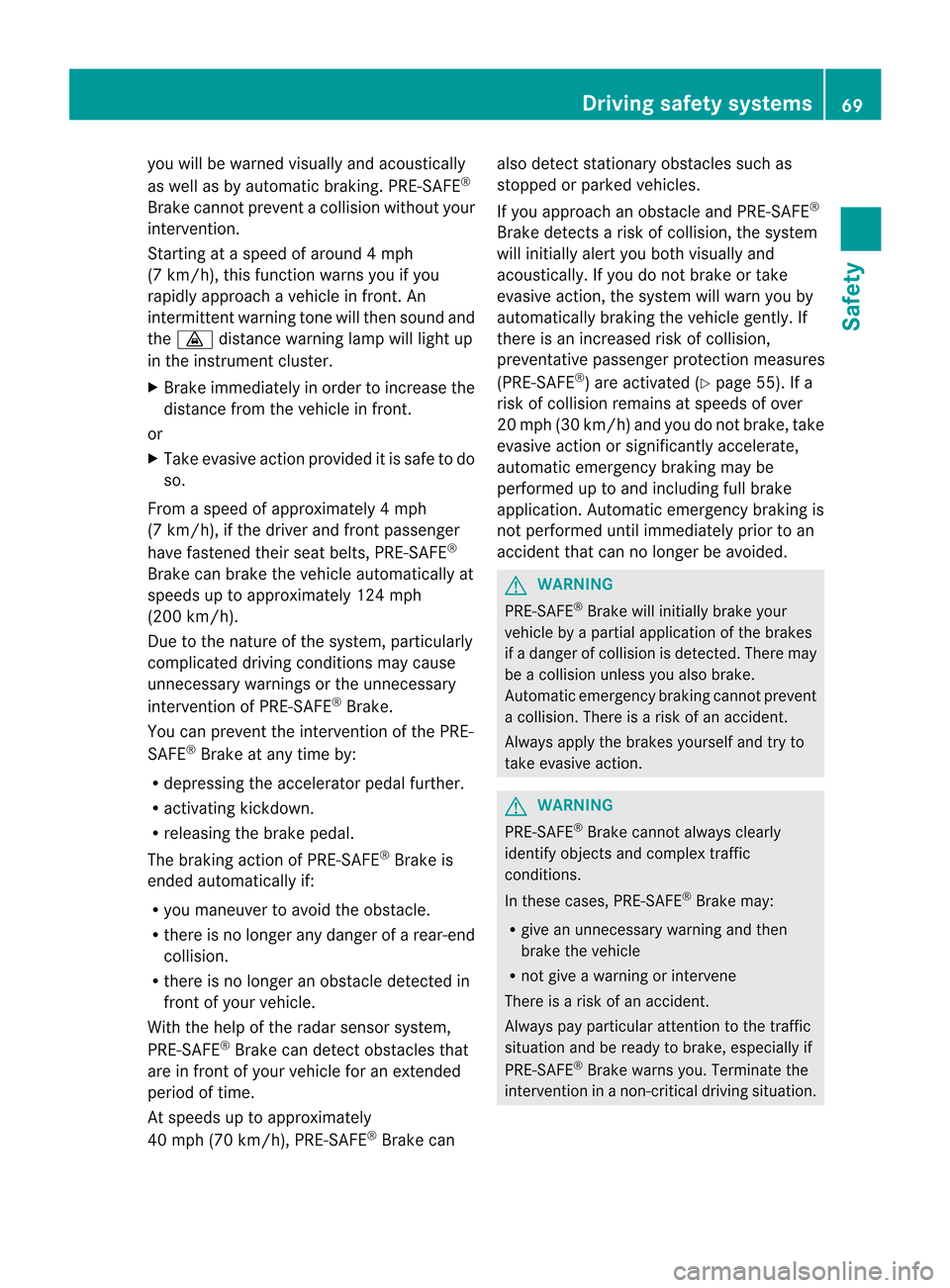
you will be warned visually and acoustically
as well as by automati
cbraking. PRE-SAFE ®
Brake cannot prevent a collision without your
intervention.
Starting at a speed of around 4 mph
(7 km/h), this function warns you if you
rapidly approach a vehicle in front. An
intermittent warning tone will then sound and
the · distance warning lamp willl ight up
in the instrument cluster.
X Brake immediately in order to increase the
distance from the vehicle in front.
or
X Take evasive action provided it is safe to do
so.
Fro maspeed of approximately 4mph
(7 km/h), if the driver and front passenger
have fastened their seat belts, PRE-SAFE ®
Brake can brake the vehicle automatically at
speeds up to approximately 124 mph
(200 km/h).
Due to the nature of the system, particularly
complicated driving condition smay cause
unnecessary warnings or th eunnecessary
intervention of PRE-SAFE ®
Brake.
You can prevent the intervention of the PRE-
SAFE ®
Brake at any time by:
R depressing the accelerator peda lfurther.
R activating kickdown.
R releasing the brake pedal.
The braking action of PRE-SAFE ®
Brake is
ended automatically if:
R you maneuve rto avoid the obstacle.
R there is no longer any danger of a rear-end
collision.
R there is no longer an obstacle detected in
front of your vehicle.
With the help of the radar sensor system,
PRE-SAFE ®
Brake can detect obstacles that
are in front of your vehicle for an extended
period of time.
At speeds up to approximately
40 mph (70 km/h), PRE-SAFE ®
Brake can also detect stationary obstacles such as
stopped or parked vehicles.
If you approach an obstacle and PRE-SAFE
®
Brake detects a risk of collision, the system
will initially alert you both visually and
acoustically. If you do not brake or take
evasive action, the system will warn you by
automatically braking the vehicle gently. If
there is an increased risk of collision,
preventative passenger protection measures
(PRE-SAFE ®
) are activated (Y page 55). If a
risk of collision remains at speeds of over
20 mph (30 km/h) and you do not brake, take
evasive action or significantly accelerate,
automatic emergency braking may be
performed up to and including full brake
application. Automatic emergency braking is
not performed until immediately prior to an
accident that can no longer be avoided. G
WARNING
PRE-SAFE ®
Brake will initially brake your
vehicle by a partial application of the brakes
if a danger of collision is detected. There may
be a collision unless you also brake.
Automatic emergenc ybraking cannot prevent
a collision. There is a risk of an accident.
Always apply the brakes yourself and try to
take evasive action. G
WARNING
PRE-SAFE ®
Brake cannot always clearly
identify objects and complex traffic
conditions.
In these cases, PRE-SAFE ®
Brake may:
R give an unnecessary warning and then
brake the vehicle
R not give a warning or intervene
There is a risk of an accident.
Always pay particular attention to the traffic
situation and be ready to brake, especially if
PRE-SAFE ®
Brake warns you. Terminate the
intervention in a non-critical driving situation. Driving safety systems
69Safety Z
Page 72 of 494
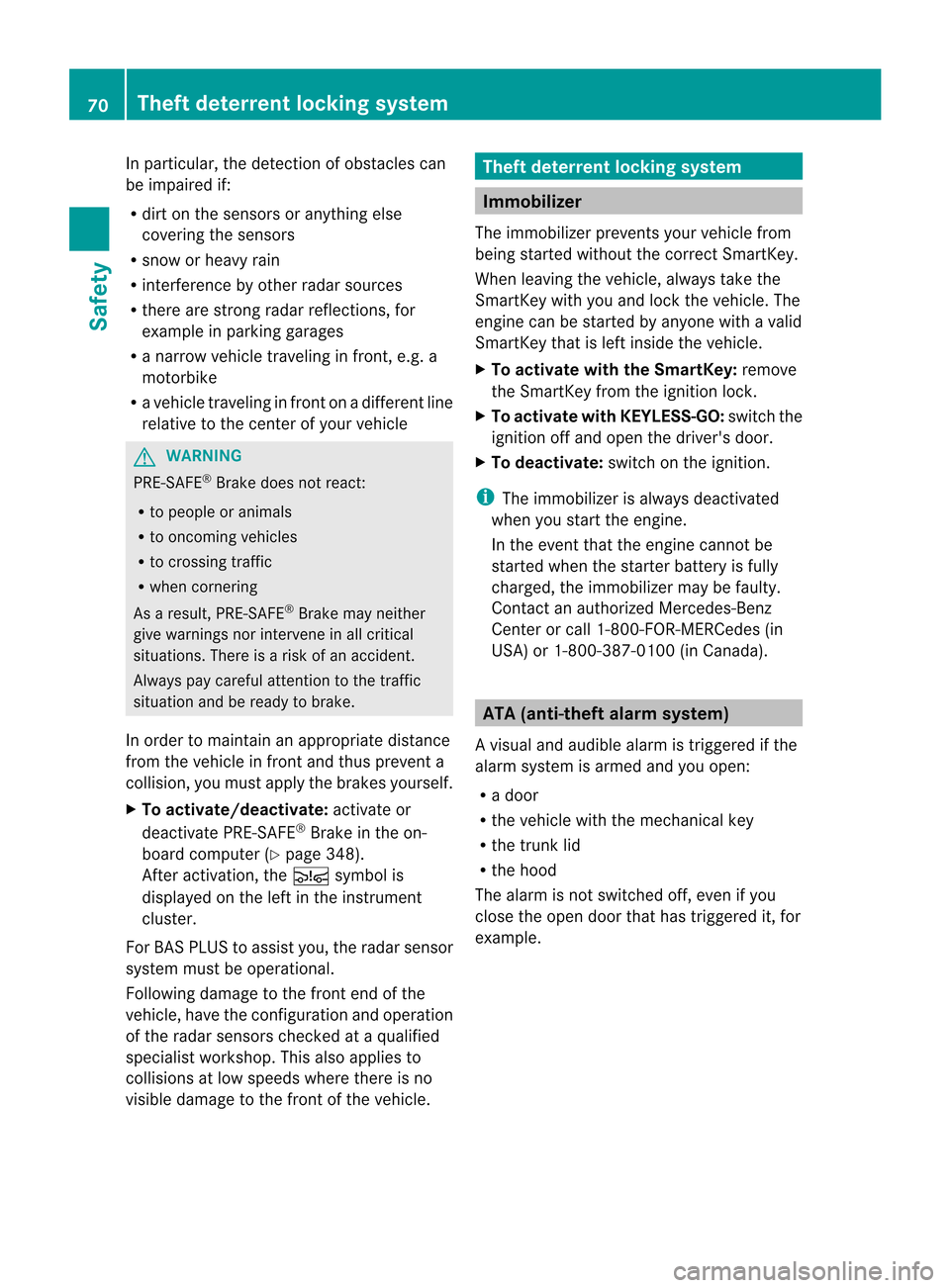
In particular, the detection of obstacles can
be impaired if:
R
dirt on the sensors or anything else
covering the sensors
R snow or heavy rain
R interference by other radars ources
R there are strong radar reflections, for
example in parking garages
R a narrow vehicle traveling in front, e.g. a
motorbike
R a vehicle traveling in front on a different line
relative to the center of your vehicle G
WARNING
PRE-SAFE ®
Brake does not react:
R to people or animals
R to oncoming vehicles
R to crossing traffic
R when cornering
As a result, PRE-SAFE ®
Brake may neither
give warnings nor intervene in all critical
situations. There is a risk of an accident.
Always pay careful attention to the traffic
situation and be ready to brake.
In order to maintain an appropriate distance
from the vehicle in front and thus prevent a
collision, you must apply the brakes yourself.
X To activate/deactivate: activate or
deactivate PRE-SAFE ®
Brake in the on-
board computer (Y page 348).
After activation, the Äsymbol is
displayed on the left in the instrument
cluster.
For BAS PLUS to assist you, the radar sensor
system must be operational.
Following damage to the front end of the
vehicle, have the configuration and operation
of the radar sensors checked at a qualified
specialist workshop. This also applies to
collisions at low speeds where there is no
visible damage to the front of the vehicle. Theft deterrent locking system
Immobilizer
The immobilizer prevents your vehicle from
being started without the correct SmartKey.
When leaving the vehicle, always take the
SmartKey with you and lock the vehicle. The
engine can be started by anyone with a valid
SmartKey that is left inside the vehicle.
X To activate with the SmartKey: remove
the SmartKey from the ignition lock.
X To activate with KEYLESS-GO: switch the
ignition off and open the driver's door.
X To deactivate: switch on the ignition.
i The immobilizer is always deactivated
when you start the engine.
In the event that the engine cannot be
started when the starter battery is fully
charged, the immobilizer may be faulty.
Contact an authorized Mercedes-Benz
Center or call 1-800-FOR-MERCedes (in
USA) or 1-800-387-0100 (in Canada). ATA (anti-theft alarm system)
Av isual and audible alarm is triggered if the
alarm system is armed and you open:
R a door
R the vehicle with the mechanical key
R the trunk lid
R the hood
The alarm is not switched off, even if you
close the open door that has triggered it, for
example. 70
Theft deterrent locking systemSafety
Page 255 of 494

=
High-bea mflasher
? Left turn signal
X To indicate briefly: press the combination
switch briefly to the pressure point in the
direction of arrow ;or?.
The corresponding tur nsignal flashes three
times.
X To indicate: press the combination switch
beyond the pressure point in the direction
of arrow ;or?.
High-beam headlamps X
To switch on th ehigh-beam headlamps:
turn the SmartKey in the ignition lock to
position 2or start the engine.
X Turn the light switch to L.
X Press the combination switc hbeyond the
pressure point in the direction of
arrow :.
The K indicator lamp in the instrument
cluster lights up.
X To switch off the high-beam
headlamps: move the combination switch
back to its normal position.
The K indicator lamp in the instrument
cluster goes out.
High-beam flasher X
To switch on: turn the SmartKey in the
ignition lock to position 1or 2or start the
engine.
X Pull the combination switch in the direction
of arrow =. Hazard warning lamps
The hazard warning lamps automatically
switch on if:
R
an air bag is deployed.
R the vehicle is slowed down rapidly from a
speed of over 45 mph (70 km/h) and
comes to a halt.
X To switch on the hazard warning lamps:
press button :.
All turn signals flash. If you now switch on
a turn signal using the combination switch,
only the turn signal lamp on the
corresponding side of the vehicle will flash.
X To switch off the hazard warning
lamps: press button :.
If the vehicle returns to a speed of over
6m ph (10 km/h) after a full application of the
brakes, the hazard warning lamps are
deactivated automatically.
i The hazard warning lamps still operate if
the ignition is switched off. Exterior lighting
253Lights and windshield wipers Z
Page 278 of 494
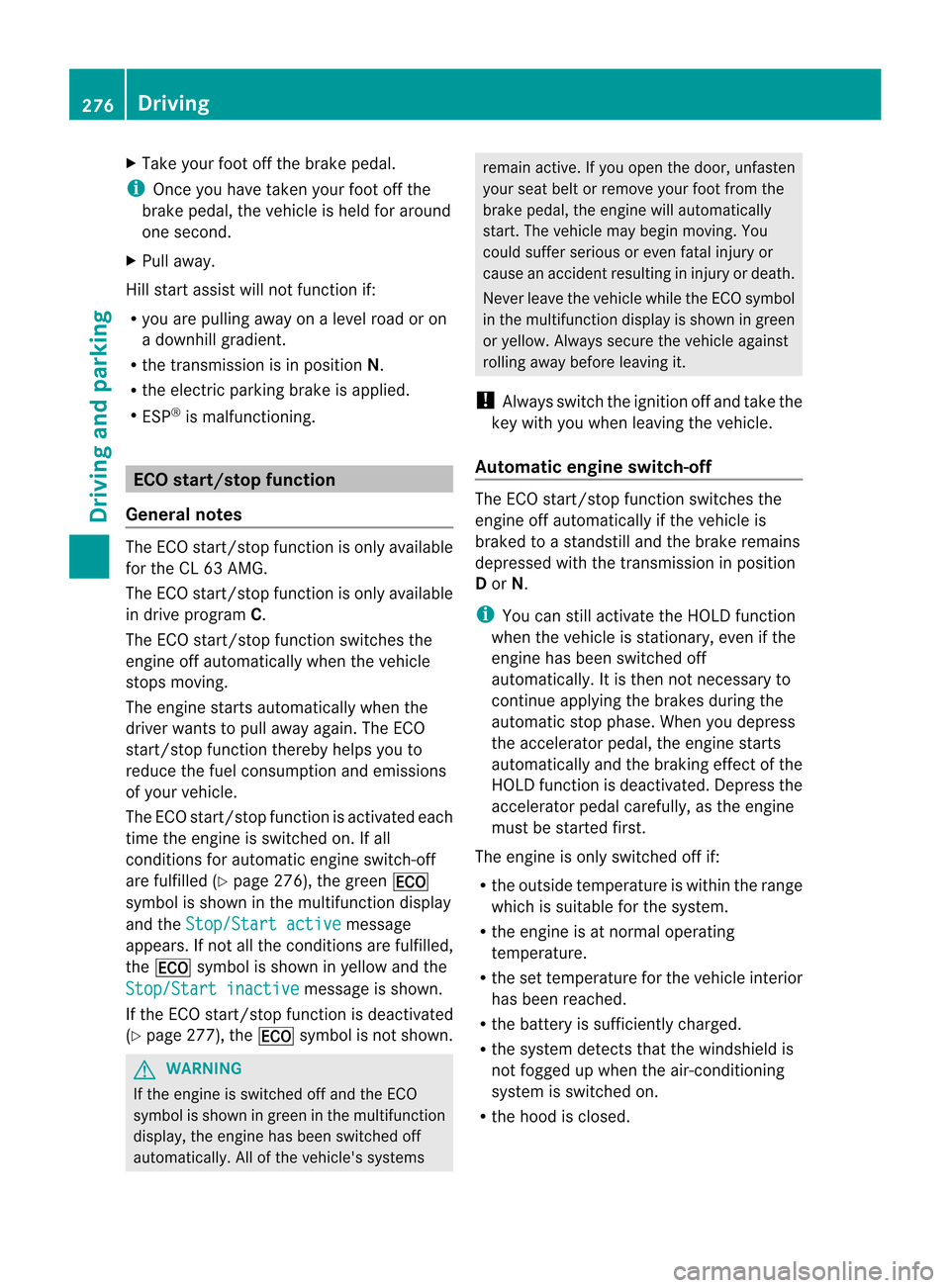
X
Take your foot off the brake pedal.
i Once you have taken your foot off the
brake pedal, the vehicle is held for around
one second.
X Pull away.
Hill start assist will not function if:
R you are pulling away on a level road or on
a downhill gradient.
R the transmission is in position N.
R the electric parking brake is applied.
R ESP ®
is malfunctioning. ECO start/stop function
General notes The ECO start/stop function is only available
for the CL 63 AMG.
The ECO start/stop function is only available
in drive program C.
The ECO start/stop function switches the
engine off automatically when the vehicle
stops moving.
The engine starts automatically when the
driver wants to pull away again. The ECO
start/stop function thereby helps you to
reduce the fuel consumption and emissions
of your vehicle.
The ECO start/stop function is activated each
time the engine is switched on. If all
conditions for automatic engine switch-off
are fulfilled (Y page 276), the green ¤
symbol is shown in the multifunction display
and the Stop/Start active message
appears. If not all the conditions are fulfilled,
the ¤ symbol is shown in yellow and the
Stop/Start inactive message is shown.
If the ECO start/stop function is deactivated
(Y page 277), the ¤symbol is not shown. G
WARNING
If the engine is switched off and the ECO
symbol is shown in green in the multifunction
display, the engine has been switched off
automatically. All of the vehicle's systems remain active. If you open the door, unfasten
your seat belt or remove your foot from the
brake pedal, the engine will automatically
start
.The vehicle may begin moving. You
could suffer serious or even fatal injury or
cause an accident resulting in injury or death.
Never leave the vehicle while the ECO symbol
in the multifunction display is shown in green
or yellow. Always secure the vehicle against
rolling away before leaving it.
! Always switch the ignition off and take the
key with you when leaving the vehicle.
Automatic engine switch-off The ECO start/stop function switches the
engine off automatically if the vehicle is
braked to a standstill and the brake remains
depressed with the transmission in position
D
or N.
i You can still activate the HOLD function
when the vehicle is stationary, even if the
engine has been switched off
automatically. It is then not necessary to
continue applying the brakes during the
automatic stop phase. When you depress
the accelerator pedal, the engine starts
automatically and the braking effect of the
HOLD function is deactivated. Depress the
accelerator pedal carefully, as the engine
must be started first.
The engine is only switched off if:
R the outside temperature is within the range
which is suitable for the system.
R the engine is at normal operating
temperature.
R the set temperature for the vehicle interior
has been reached.
R the battery is sufficiently charged.
R the system detects that the windshield is
not fogged up when the air-conditioning
system is switched on.
R the hood is closed. 276
DrivingDriving and parking